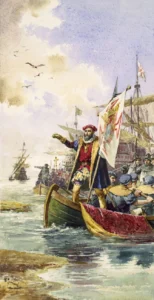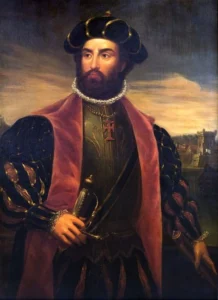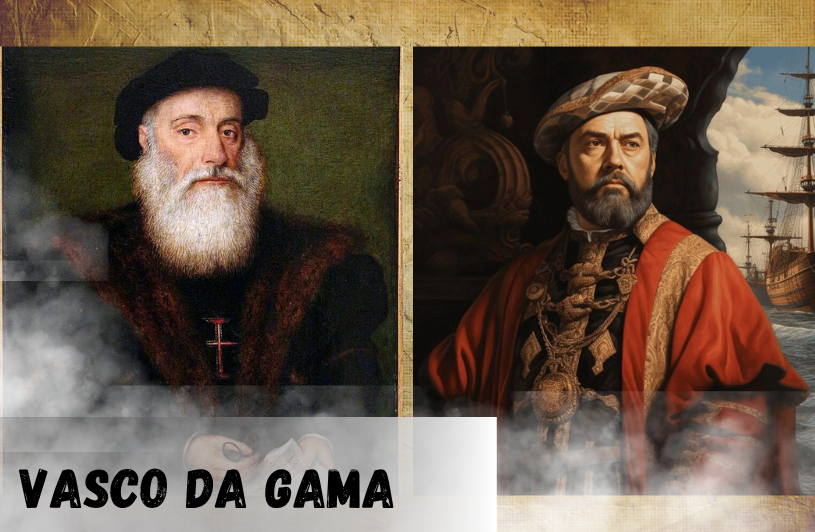Early Life
Vasco da Gama was born in 1460 in Sines which was a small coastal Portuguese town. He was the son of Esteao da Gama who was a knight, and the commander of the castle at Sines. His mother was Isabel Sodre. Vasco had been familiarized with ships when he was growing up next to the sea. He also learned science of navigation, mathematics and geography in town Évora.
Vasco da Gama was able to command a ship at the time when he was a young man. During this period, Portugal was investing in the sea voyages. This was aimed at locating a route straight to India-a country that produced spices especially pepper, cinnamon, and cloves that were costlier than gold. 
First Voyage to India (1497–1499)
Vasco da Gama sailed on July 8 1497, out of Lisbon on a fleet of four ships, the names of which were sail Ranked in order São Gabriel, São Rafael, Berrio, and provision ship. His crew consisted of 170 people.
Vasco da Gama’s and his men sailed far away beyond the coast of Africa to the Atlantic Ocean to seek fresher winds instead of remaining near Africa. This trip lasted through weeks and by November 22, they passed around the Cape of Good Hope, the southern most point of Africa.
They had halted at such places as Mossel Bay, Mozambique, Mombasa and Malindi. At Malindi they met with a local navigator, probably an Arab or local Muslim, who accompanied the fleet across the ocean.
At last they arrived at Calicut (now Kozhikode) in the west coast of India on May 20 1498. They were received by the local ruler called the Zamorin. Vasco presented gifts, red cloaks, hats, coral, brass, sugar, oil, honey but these gifts were also not worth as gold and silver hence they got to be unimpressive. 
Vasco da Gama attempted to conduct trade agreements yet cultural and language differences, misunderstandings, and local Muslim traders resulted in conflicts.
Vasco da Gama took hostages to show he had reached his goal and left in August 1498, but things were hard. Many sailors died of scurvy and illness. The São Rafael was burned to stop disease from spreading. Only 54 crew members and three ships returned to Lisbon by September 1499.
Despite the losses, Portugal celebrated Vasco’s success. He had discovered the first sea route directly linking Western Europe to India. This changed trade forever.
Second Voyage (1502–1503)
Vasco’s first trip was seen as a big win—so King Manuel I sent him back with 10 warships in early 1502.
This time, relations were not friendly. In Kilwa (Tanzania), he forced local rulers to swear loyalty to Portugal. In Calicut, he bombarded the port, fought Arab ships, and forced the Zamorin into a trade treaty.
In January 1503, a battle took place off Calicut’s coast. Vasco’s fleet used a line-of-battle formation and defeated a large Arab fleet.
He then went to Cochin, where he secured Portuguese influence by supporting a friendly local ruler. Vasco returned to Portugal in October 1503, heavily laden with spices and seen by many in Portugal as a hero—though many in India remember him for his violence.
Life Between Voyages (1503–1524)
After his second return, Vasco da Gama married Catarina de Ataíde. They had six sons and a daughter. He lived mostly in Évora, advising the king on Indian affairs, but did not return to India for over 20 years. Other leaders, like Afonso de Albuquerque, became more important in the region.
In 1519, recognizing his importance, King Manuel I made Vasco the Count of Vidigueira. The title gave him land and money. The title was created on December 29, 1519, making him noble and wealthy.
Though honored, he sometimes threatened to leave Portugal for Spain. Worried, King Manuel moved quickly to secure him as an important noble.
Final Voyage & Death (1524)
In 1524, under King John III, Vasco was sent back to India as Viceroy of India. His task: to fix corruption among Portuguese officials and restore order.
Vasco da Gama arrived in Goa in September and then went to Cochin, but became ill with malaria. He died on December 24, 1524—Christmas Eve—at the age of about 64. He was buried in Cochin and later his body was returned to Portugal in 1539, resting in the Jerónimos Monastery in Lisbon.
Legacy & Impact
-
Sea Route to India
Vasco da Gama’s first voyage opened a new sea path around Africa, linking Europe directly with India. This allowed Portugal to trade spices and other riches without needing the old land routes controlled by Arab traders. -
Wealth for Portugal
This new route made Portugal a rich and powerful nation. Spices, wealth, and colonial influence came to their shores for decades. -
Colonial Rule Begins
Vasco’s voyages marked the start of European colonial power in Asia and Africa. Forts, trading posts, ships—they all followed. While bringing wealth to Europe, they also brought conflict, war, and suffering to local populations. -
Mixed Memory
In Portugal, he is a hero: noble, brave, and a navigator who changed the world. In parts of India and East Africa, he is remembered for violence, hostility, and the beginning of colonial abuse. -
Honors & Namesakes
-
In 1519, he was given the title Count of Vidigueira.
-
In 1524, he became Viceroy of India.
-
Many places are named after him: roads, bridges, churches (like the Vasco da Gama Bridge in Lisbon), towns in India, and stadiums in Brazil.
-
Remembering Vasco da Gama Today
-
His voyages are taught in history as key moments in world exploration.
-
Spices became affordable in Europe, changing diets and economies.
-
Colonization started, for better or worse, leading to a modern global society.
-
Portuguese culture spread; languages, religions, and buildings still stand in former colonies.
-
He will always remain a figure with both great achievements and harsh legacy.
Conclusion
Vasco da Gama was a brave man who sailed into the unknown and found a direct ocean path to India. This changed the world. He brought wealth and power to Portugal—but also conflict and suffering in foreign lands. He died far from home but left a legacy that shaped global history.
🎉✨ Meet Nischay Malhan (aka Triggered Insaan)! The IIT-graduate turned YouTube superstar 🤯 – famous for his epic roast & reaction videos 🎤🔥 – now married to his long-time love 💍❤️
